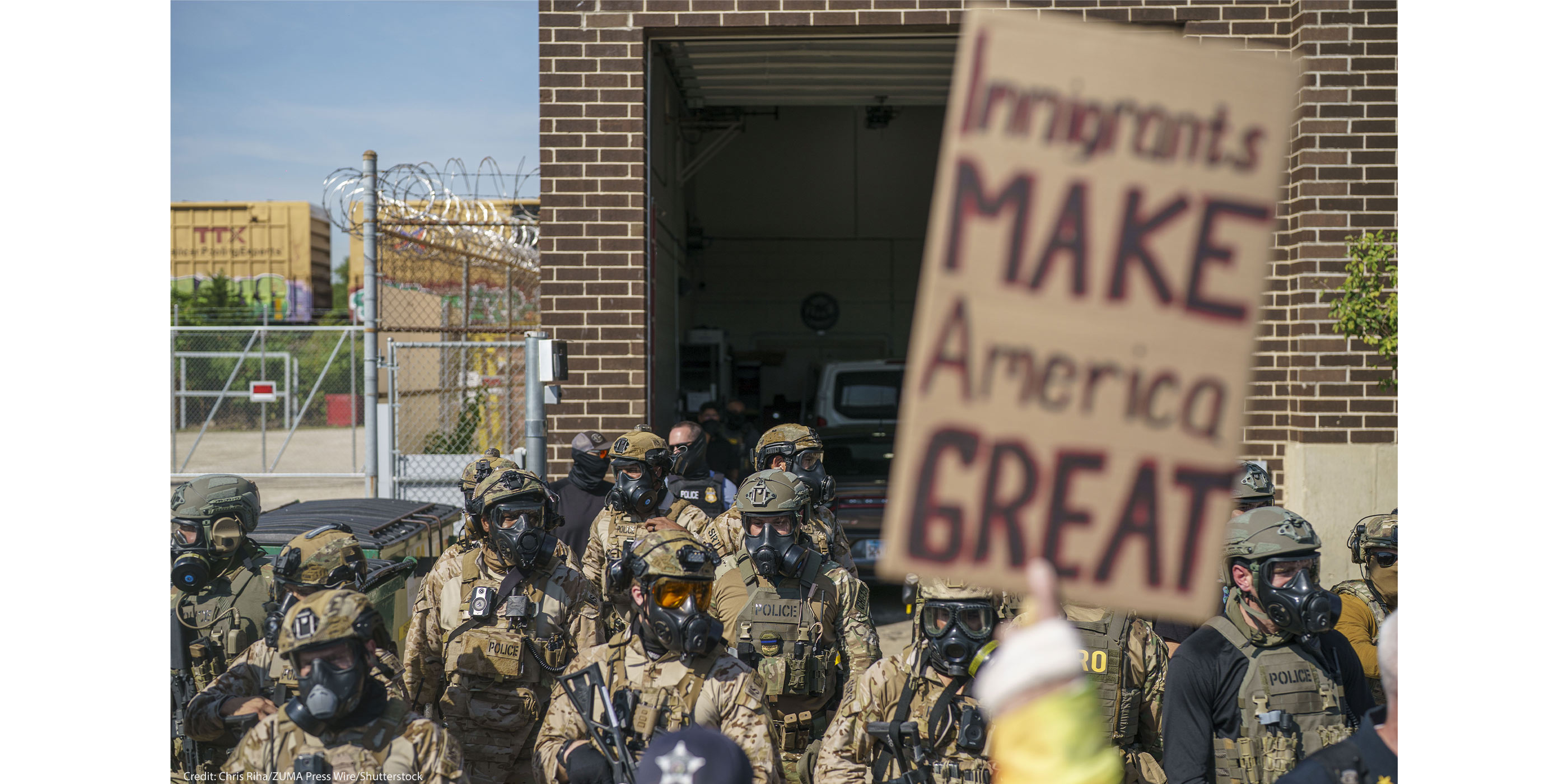Border Patrol Agents Replace Top Leadership at ICE Offices Despite Human Rights Violations – American Civil Liberties Union

Report on U.S. Immigration Enforcement Restructuring and its Implications for Sustainable Development Goals
1.0 Executive Summary
This report analyzes recent changes in the leadership and operational strategy of United States immigration enforcement, specifically the replacement of Immigration and Customs Enforcement (ICE) officials with personnel from U.S. Customs and Border Protection (CBP), particularly its Border Patrol subagency. These developments are examined through the framework of the United Nations Sustainable Development Goals (SDGs), with a focus on SDG 16 (Peace, Justice and Strong Institutions), SDG 10 (Reduced Inequalities), and SDG 11 (Sustainable Cities and Communities).
2.0 Operational and Leadership Restructuring
2.1 Shift in Immigration and Customs Enforcement (ICE) Leadership
A significant overhaul of immigration enforcement leadership has been initiated, with reports indicating that nearly half of the top leadership positions at ICE offices nationwide are being filled by current or retired Border Patrol officers. This strategic shift places personnel from an agency historically focused on border interdiction into roles governing interior civil immigration enforcement.
2.2 Expansion of Enforcement Tactics in Urban Centers
The leadership change coincides with an escalation of enforcement tactics within major U.S. cities, moving beyond traditional immigration enforcement activities. Reported tactics include:
- Deployment of tear gas in residential neighborhoods.
- Use of military-style hardware, such as Black Hawk helicopters, for nighttime raids on apartment buildings.
- Utilization of predator drones for surveillance of public protests.
- Physical altercations with civilians, including U.S. citizens.
3.0 Institutional Profile of U.S. Border Patrol
3.1 Agency Overview
U.S. Customs and Border Protection (CBP) is one of the world’s largest law enforcement organizations, employing approximately 60,000 agents. Its subagency, the U.S. Border Patrol, comprises nearly 20,000 agents and has received funding for an additional 10,000 personnel.
3.2 Record of Accountability and Human Rights
For years, the Border Patrol has faced scrutiny regarding its conduct, use of force, and institutional accountability. This record is critical when evaluating its expanded role in interior enforcement and its alignment with global development standards.
- Fatal Encounters: In the last 15 years, nearly 200 fatalities have been reported as a result of encounters with Border Patrol agents. These include deaths from use-of-force, cross-border shootings, and vehicle pursuits.
- Lack of Accountability: Despite documented deaths and allegations of excessive force, inadequate medical care, and neglect in custody, no agent has reportedly ever been convicted of criminal wrongdoing for actions taken while on duty.
- Internal Concerns: A former internal affairs chief at CBP previously warned that the agency was “engineered to interfere with our efforts to hold the Border Patrol accountable.”
4.0 Analysis of Impacts on Sustainable Development Goals (SDGs)
4.1 SDG 16: Peace, Justice and Strong Institutions
The reported operational culture and lack of accountability within the Border Patrol present significant challenges to the achievement of SDG 16.
- Target 16.6 (Effective, Accountable, and Transparent Institutions): A documented history of impunity and internal warnings about evading legal restraints directly conflicts with the goal of developing accountable and transparent institutions.
- Target 16.3 (Promote the Rule of Law and Ensure Equal Access to Justice): When a law enforcement agency operates with limited accountability, it undermines the rule of law and the principle of equal access to justice for all individuals, including migrants and citizens.
- Target 16.1 (Reduce All Forms of Violence): The high number of fatalities associated with agency encounters and the use of aggressive tactics in communities are contrary to the goal of reducing violence.
4.2 SDG 10: Reduced Inequalities & SDG 11: Sustainable Cities and Communities
The deployment of Border Patrol agents into diverse urban centers has direct implications for social equity and community safety.
- Target 10.7 (Orderly, Safe, Regular and Responsible Migration): An enforcement strategy characterized by aggressive and unpredictable tactics may undermine efforts to facilitate safe and orderly migration, instead fostering fear and instability within immigrant communities.
- Target 11.7 (Access to Safe and Inclusive Public Spaces): The use of tear gas and surveillance drones in residential areas and at public gatherings compromises the safety and inclusivity of urban communities, potentially deterring civic engagement and fostering a climate of fear.
5.0 Inter-Agency Collaboration and Governance Concerns
5.1 The 287(g) Program
The expansion of Border Patrol’s influence is magnified through the 287(g) program, which allows state and local police to perform federal immigration enforcement duties. With Border Patrol officials now in leadership roles, there is a risk that their institutional culture and tactics could be transferred to over 1,000 participating local law enforcement agencies, further challenging the achievement of SDG 16 at the local level.
5.2 Conclusion
The restructuring of U.S. immigration enforcement to prioritize the operational approach of the Border Patrol raises significant concerns regarding its alignment with the Sustainable Development Goals. The emphasis on aggressive tactics, combined with a history of limited accountability, poses a direct challenge to the development of just, peaceful, and inclusive societies as envisioned by the 2030 Agenda for Sustainable Development. Congressional and civic oversight is essential to ensure that law enforcement institutions remain accountable, transparent, and committed to protecting the rights and safety of all individuals.
SDGs Addressed in the Article
-
SDG 16: Peace, Justice and Strong Institutions
This goal is central to the article, which focuses on the breakdown of justice, accountability, and institutional integrity within U.S. immigration enforcement agencies. The text describes a “lawless agency,” a “culture of cruelty, racism, and impunity,” and a complete lack of accountability (“No agent has ever been convicted of criminal wrongdoing while on duty”), all of which directly challenge the principles of strong, just, and accountable institutions.
-
SDG 10: Reduced Inequalities
The article highlights policies and actions that disproportionately target a specific group—immigrants—based on their origin and status. The discussion of the “family separation policy,” “mass deportation” operations, and a culture of “racism” points to practices that increase inequality and undermine the social inclusion and rights of migrants and their communities.
Specific SDG Targets Identified
SDG 16: Peace, Justice and Strong Institutions
-
Target 16.1: Significantly reduce all forms of violence and related death rates everywhere.
The article directly relates to this target by documenting violence perpetrated by state agents. It cites that “nearly 200 people have died as a result of encounters with Border Patrol,” including “70 use-of-force cases” and fatal shootings. The use of “tear gas in residential neighborhoods” and violent attacks on citizens are further examples of violence discussed.
-
Target 16.3: Promote the rule of law at the national and international levels and ensure equal access to justice for all.
This target is undermined by the article’s core theme of impunity. The statement that “No agent has ever been convicted of criminal wrongdoing while on duty, despite documented deaths” demonstrates a failure of the justice system. The description of the agency as engaging in “reckless, abusive, unconstitutional conduct” and going “out of its way to evade legal restraints” shows a clear departure from the rule of law.
-
Target 16.6: Develop effective, accountable and transparent institutions at all levels.
The article portrays the Border Patrol and the new ICE leadership as the opposite of accountable and transparent institutions. It describes a “longstanding crisis of accountability” and notes that the replacement of career officials is “designed to silence dissent,” which erodes institutional effectiveness and transparency in favor of a politicized agenda.
SDG 10: Reduced Inequalities
-
Target 10.2: Empower and promote the social, economic and political inclusion of all, irrespective of… origin… or other status.
The enforcement tactics described in the article—such as arresting parents, dragging people into unmarked vans, and implementing the “family separation policy”—are actions of exclusion. They are designed to terrorize and remove a specific population based on their immigration status and origin, directly opposing the goal of social inclusion.
-
Target 10.3: Ensure equal opportunity and reduce inequalities of outcome, including by eliminating discriminatory laws, policies and practices.
The article points to discriminatory practices through its mention of a “culture of cruelty, racism, and impunity.” The aggressive enforcement targeting immigrant communities and the jokes about migrant deaths in a Border Patrol Facebook group are evidence of practices that create profoundly unequal outcomes (fear, detention, death) for this group compared to the general population.
-
Target 10.7: Facilitate orderly, safe, regular and responsible migration and mobility of people, including through the implementation of planned and well-managed migration policies.
The policies and actions described are the antithesis of “orderly, safe, and responsible” migration management. The article details a “campaign of terror,” “brazen and aggressive” raids, and violent tactics. This approach creates a hostile and dangerous environment, undermining any semblance of safe or well-managed migration policy.
Indicators for Measuring Progress
The article implies several indicators that could be used to measure the lack of progress towards the identified targets:
SDG 16: Peace, Justice and Strong Institutions
-
Implied Indicator for Target 16.1: Number of deaths and injuries resulting from encounters with law enforcement.
The article provides specific data points that align with this, stating, “In the last 15 years, nearly 200 people have died as a result of encounters with Border Patrol,” including “70 use-of-force cases” and “more than 100 fatalities from Border Patrol-led car chases.”
-
Implied Indicator for Target 16.3: Number of law enforcement officials investigated, prosecuted, and convicted for abuses or misconduct.
The article provides a stark measure for this indicator by stating, “No agent has ever been convicted of criminal wrongdoing while on duty.” This figure serves as a direct measure of the lack of accountability and failure to provide justice.
SDG 10: Reduced Inequalities
-
Implied Indicator for Target 10.3: Reports of discrimination and harassment experienced by specific population groups (e.g., migrants).
While not providing a quantitative survey, the article implies this indicator through its descriptions of a “culture of cruelty, racism,” jokes about “migrant deaths,” and the terrorizing of communities. The violent attack on a U.S. citizen and raids on apartment buildings where “U.S. citizens and children” were pulled from their beds also serve as examples of discriminatory practices affecting specific communities.
Table of SDGs, Targets, and Indicators
| SDGs | Targets | Indicators (Mentioned or Implied in the Article) |
|---|---|---|
| SDG 16: Peace, Justice and Strong Institutions | 16.1: Reduce all forms of violence and related death rates. | The number of deaths from encounters with Border Patrol (nearly 200 in 15 years). |
| SDG 16: Peace, Justice and Strong Institutions | 16.3: Promote the rule of law and ensure equal access to justice. | The number of agents convicted of criminal wrongdoing while on duty (zero). |
| SDG 16: Peace, Justice and Strong Institutions | 16.6: Develop effective, accountable and transparent institutions. | Evidence of a “crisis of accountability” and actions “designed to silence dissent” within enforcement agencies. |
| SDG 10: Reduced Inequalities | 10.2 & 10.3: Promote inclusion and eliminate discriminatory practices. | Implementation of discriminatory policies like “family separation” and evidence of a “culture of cruelty, racism.” |
| SDG 10: Reduced Inequalities | 10.7: Facilitate orderly, safe, regular and responsible migration. | Description of immigration enforcement as a “campaign of terror” with “brazen and aggressive” tactics, contrary to safe migration principles. |
Source: aclu.org
What is Your Reaction?
 Like
0
Like
0
 Dislike
0
Dislike
0
 Love
0
Love
0
 Funny
0
Funny
0
 Angry
0
Angry
0
 Sad
0
Sad
0
 Wow
0
Wow
0



















































.jpg.webp?itok=0ZsAnae9#)

























